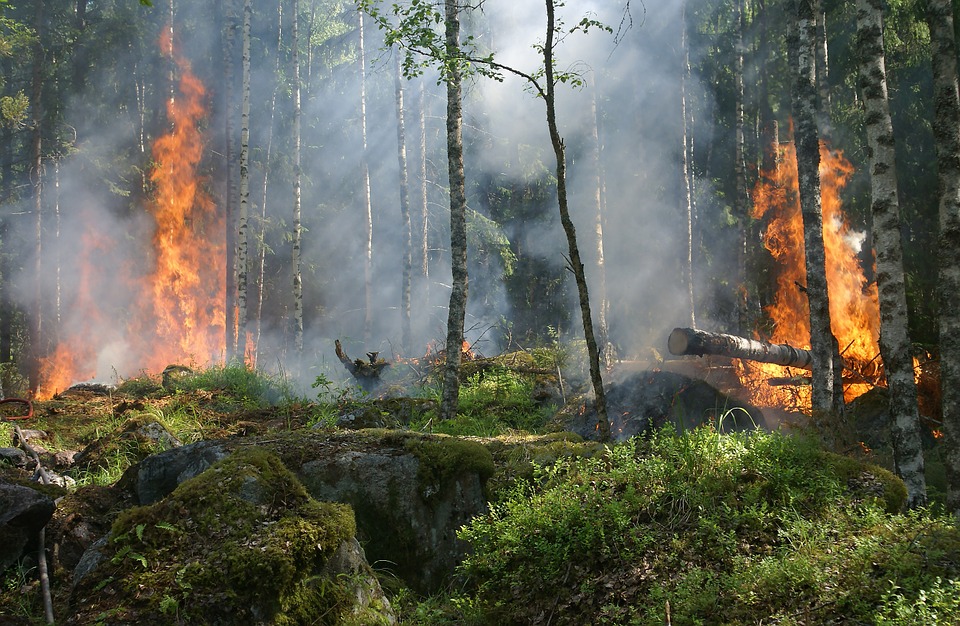Although sometimes we forget it, forests provides huge benefits to the planet in general and to the human being in particular. They help us to mitigate climate change effects acting as carbon sinks and eliminating huge quantities of carbon dioxide of the atmosphere. The forests nourish the ground and serve as a natural barrier against ground erosion, ground movements, floods, avalanches and strong winds. Forests host more than three quarters of global terrestrial biodiversity, and represents a source of food, medicines and fuel for more than one thousand million people.
But forests are seriously threatened by deforestation, climate change and fires. The advance of the agricultural frontier and the unsustainable logging causes 13 million hectares of forest to be lost every year. Climate change is allowing that plants and invasive insects species have advantages over the native species increasing their negative effects. It also exists a direct relationship between fires, deforestation and pandemics: the destruction of forests, specially the tropical ones such as the Amazonia, Indonesia or the Congo, makes possible that human beings get in touch with wildlife populations carriers of pathogens.

With regard to forest fires it has been noted that fires are becoming less frequent, but more destructive. Some of them, the most terrible, are the called “sixth generation fires“, and are ravaging the forests of the planet. This type of fires can´ t be fight and also they have the capacity to modificate the metheorology of the place where the fire is located. Against this type of fires it only works a defensive strategy, trying to direct it to non-populated areas and hope that the rain will help to control it. Not even areas that have hardly had any fires are not spared from this tragedy: 5.5 millions of hectares have burned in the Artic Circle in recent years. The Artic is warming twice as fast as the rest of the planet and, as a result, high intensity fires are starting.
It is clear that is fundamental to prevent fires and for that reason it is necessary to consider strategies that allows reducing forests vulnerability. Having a look at our nearer context, the European Union forest strategy promotes the forest sustainable and respectful management with climate and biodiversity, intensifying the surveillance of forests and giving a more specific support to silvicultures. Becomes evident that is needed a better forestry management with emphasis in the protection and sustainable regeneration. However, we have a steady decline in forest mass as the “reforestation” process cannot compete with the deforestation rate in Europe. Furthermore, in Europe, data shows a large increase in forestry exploitation in recent years, which reducing the continent´ s CO2 absorption capacity and possibly indicating wider problems with the EU´ s attempts to fight agains climate crisis. Another paradox regarding forests within the EU is that a large part of them are privately owned by timber companies. As a result, the regular logging of these forests, coupled with the private nature of their ownership, makes public awareness and greenning even more difficult to achieve. Biomass loss from 2016 to 2018, in compared to the period from 2011-2015, has increased by 69%, according to the satellite data.
Spain, as it occurs to all the countries of the mediterranean area, is specially vulnerable to fires, given the scenario of drought and desertification, accelerated by the climate change. In Spain we have a large experience putting out forest fires: we collaborate in a international level and we achieve the extinction of 65% of fires in their outbreak phase (less than 1 hectare), although this sometimes produces the effect called “the extinction paradox” (which means that we lose the opportunity for small fires to clear undergrowth and thus encourage large and dangerous accumulations of fuel. In Spain 1,000 million euros per year are destiny to fire extinction, however, only 300 millions euros to their prevention.
The extinction is necessary and positive but isn´ t enough, it is necessary to invest in other measures (prevention, detection and recovering) that allows facing forest fires from a more wide and complete perspective. In this sense is very important to take advantage of new tools that offers recent technologies and scientific advances.

For example, the use of images obtained with drones and satellites and sensor grids joint with artificial intelligence techniques allows to detect fires faster and more accurately and is already underway several research projects in various countries: Bulgary, Greece, Portugal, Lebanon, Korea and much others. Even there are challenges planned for the European Spacial Agency for using satellite images and artificial intelligence in the detection of fires and other similar challenges of the NASA, H20.ai and Cellnex. Another interesting initiative is ALERTWildfire, a consortium of several northamerican universities that provides cameras and tools against fires to discover, locate and monitor forest fires. There are also commercial systems to detect forest fires, such as this one of Chile, that use Artificial Intelligence and several types of sensors or this one of Portugal.
Already in Spain, the Ecology Transition and Agriculture ministries have developed Arbaria project able to “predict” with a considerable hit rate where fires will break out.
Looking for a global approach in the prevention and management of fires the european project DRYADS have been launched, in which participates CARTIF. This project has as an objective the development of a fire management holistic platform based in the optimization and reuse of last generation socio-technologic resources. These techniques will be applied in the three main phases of forest fires:
- In the prevention phase, DRYADS proposes the use of a real-time risk assessment tool that can receive multiple ranking inputs and work with a new risk factor indicator driven by a neuronal network. To create a community model adapted to fire, in parallel to the previous activity, DRYADS will use construction materials activated by alcali that integrates post-fires wood ashes for buildings and infrastructures resistant to fire. DRYADS will also use a variety of technological solutions, such as the Copernicus european satellite infrastructure and swarms of drone for a precise forest supervision.
- In the detection phase, DRYADS proposes several technology tools that can be adapted to much of the needs of the project: use of virtual reality for the training, portable devices for the emergency services protection team, vehicles without driver -UAV (drones), UAG and aircrafts- to improve the capacity of temporary and spacial analysis, as well as to increase the coverage of the inspected area.
- Finally, DRYADS will construct a new forestry restoration initiative based in modern techniques, such as agrosilviculture, drones for spreading seeds, IoT sensors that can adapt the seeding process in function of the ground needs and at the same time with the help of the AI to determine the risk factors after the fire.

The results of DRYADS project will be demonstrated and validated in real conditions in several forestry spaces of Spain, Norway, Italy, Rumany, Austria, Germany, Greece and Taiwan.
To sum up and as a conclusion, to fight against the forestry fires we have not only to focus in their extinction but also in a good sustainable management of the forest based in the prevention and introduction of modern techniques is essential to reinforce their resilience, the utilisation of the resources and their recovery capacity. This will lead to new opportunities for the rural environment, the biodiversity conservation and the fight against climate change. Let us hope that for once a time trees let us see the forest and we could avoid their destruction.
- Collaborative robots: new work employees on construction - 31 July 2024
- New strategies (and technologies) against huge forest fires - 11 February 2022
- Improvement of the road maintenance through Artificial Intelligence - 29 October 2021
